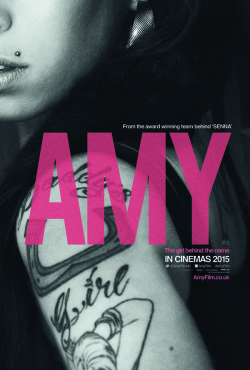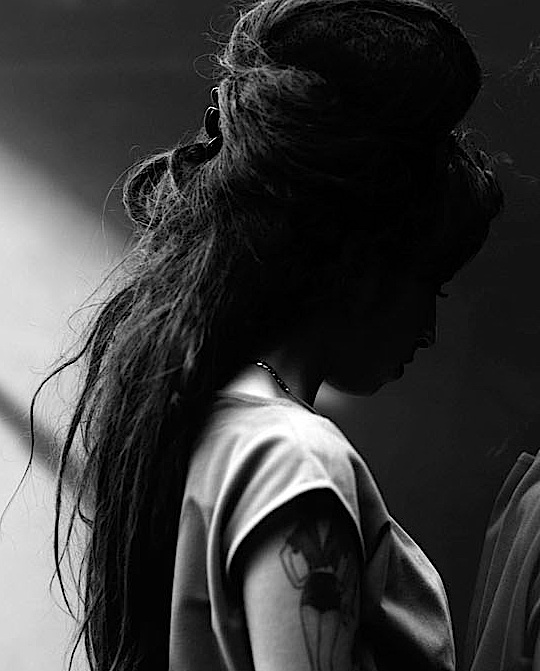EDITOR’S NOTE: To mark the eighth anniversary of Amy Winehouse’s criminally premature passing on July 23rd, 2011, we’re reposting our review of Asif Kapadia’s heartbreaking 2015 documentary, Amy.
AMY (2015, directed by Asif Kapadia, 128 minutes, USA)
BY JONATHAN VALANIA The fallen jazz singer Amy Winehouse was a heartbreaking work of staggering genius. The new documentary Amy, which maps with the clarity of hindsight Winehouse’s fairly meteoric rise and precipitous demise, is not far behind. Directed by Asif Kapadia (Senna), Amy arrives barely four years after her ridiculously premature death at the age of 27 from a combination of chronic bulimia, bottomless alcoholism and seizure-inducing quantities of crack and heroin, all of it pitilessly documented by the voracious, strobe-flashed wolfpacks of the London tabloids. The film will ensure that the toxic storylines of The Sun and The Daily Mail and the smarmy mockery of countless clueless talking heads will not harden into history and epitaph. Told almost entirely with archival footage — home movies, cellphone video, voicemails, on-camera interviews and concert footage — Amy sets the record straight, sorting the heroes from the villains — and sadly enough, there are no heroes, just villains and victims.
Teddy bear-like Nick Shymansky — who discovered Winehouse when she was 16 and he was the ripe old age of 19 and managed her career up until the  release of Back to Black — is the closest thing to a hero in the film. Before anyone else, he realized she was in trouble and tried, as the song goes, to make her go to rehab only to be vetoed by Amy’s parasitic father, Mitch. The final image of the film is fittingly voyeuristic and crushingly sad. Captured from a vantage point just outside the radius of personal space by the hi-def zoom lens of the ever–present paparazzo, it shows the attendees of Winehouse’s funeral spilling out onto the street afterwards and a visibly gutted Shymansky sobbing in anguish. It’s nearly impossible to watch without joining him.
release of Back to Black — is the closest thing to a hero in the film. Before anyone else, he realized she was in trouble and tried, as the song goes, to make her go to rehab only to be vetoed by Amy’s parasitic father, Mitch. The final image of the film is fittingly voyeuristic and crushingly sad. Captured from a vantage point just outside the radius of personal space by the hi-def zoom lens of the ever–present paparazzo, it shows the attendees of Winehouse’s funeral spilling out onto the street afterwards and a visibly gutted Shymansky sobbing in anguish. It’s nearly impossible to watch without joining him.
As for villains, there’s Mitch Winehouse, never quite finding the right balance between being her father and her employee; vampiric ex-husband and drug buddy Blake Fielder-Civil, with whom she shares a squalid Sid & Nancy-like codependency; and manager/booking agent Raye Cosbert, who had a direct financial stake in forcing her on stage, long past the point she had any business being there. Each one a deadly combination of exploiter and enabler, together they make up the three horsemen of Amy Winehouse’s apocalypse. None of them seemingly capable of seeing the terminal severity of Winehouse’s illness or hearing her coded pleas for help, or simply willing to turn a blind to eye to keep the money coming in. Winehouse parted ways with Shymansky just prior to the release of Back to Black, so by the end of her life the only person on her payroll willing to speak truth to power was her bodyguard, Andrew Morris. But by the time he shows up she already has one foot in the grave.
Beyond the post-mortem, the film makes a convincing case for Winehouse’s genius as a jazz singer and lyricist. We see her wowing intimate jazz bars and record label execs, in the vocal booth cutting the foreboding coda of Back to Black’s title track, and there’s testimonials from the likes of Tony Bennett — one of her idols, whom she duetted with shortly before her death — declaring her in the same league as Billie Holiday, Ella Fitzgerald, Sarah Vaughn and Dinah Washington. And he would know.
When we first meet Amy, she is sucking on a lollipop and hamming it up for the camera, belting out a room-silencing rendition of “Happy Birthday” during a friend’s 14th birthday party. Later we catch her napping shyly in the backseat of Shymansky’s car during a promotional tour for her first album, or spackling on the heavy black eyeliner backstage, or flirting in the back of a taxi. She is bright-eyed, curvaceous and lit from within, with a gift for barbed asides that would serve her well as a songwriter. By the onset of her fame, she is sullen and shrunken, rawboned and junkie-thin beneath a towering Spectorian girl group beehive and jailhouse tattoos. The light has already gone out. Miserably famous, she is haunted and hunted. The film makes the case that the very factors that fueled her songwriting and, as a result, her stratospheric rise — the psychic damage incurred in adolescence from her father’s infidelity and her mother’s enabling passivity, her clinical depression, the debilitating insecurity and self-loathing that triggered her bulimia and a bottomless appetite for drink and drugs to stave off the encroaching darkness — hastened her downward spiral. Like all doomed addicts, Amy Winehouse’s worst enemy was herself. Deep down she knew that. She told us she was trouble. “I cheated myself,” she sang with tragic prescience, “like I knew I would.”

